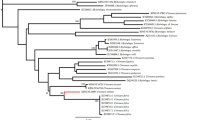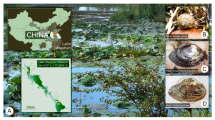Abstract
Recent molecular analyses consistently resolve the “spoon worms” (Echiura) as a subgroup of the Annelida, but their closest relatives among annelids still remain unclear. Since the adult morphology of echiurans yields limited insight into their ancestry, we focused on characters of their larval anatomy to contribute to this discussion. Electron microscopical studies of the larval protonephridia (so-called head kidneys) of the echiuran species Thalassema thalassemum revealed distinct correspondences to character states in serpulid polychaetes, although a close relationship between Echiura and Serpulidae is not supported by any phylogenetic analysis. The larval head kidneys of T. thalassemum consist of only two cells, a terminal cell and a duct cell. The terminal cell forms a tuft of six cilia projecting into the lumen of the terminal cell. The cilia are devoid of circumciliary microvilli. A filter structure is formed by two to three layers of elongate microvilli that surround the lumen of the terminal cell in a tubular manner. A thin layer of extracellular matrix (ECM) encloses the outer microvilli of the tubular structure. The tips of the microvilli project into the lumen of the adjacent duct cell but are not directly connected to it. However, mechanic coupling is facilitated by the surrounding ECM and abundant hemidesmosomes. The distal end of the multiciliary duct cell forms the external opening of the nephridium; a specialized nephropore cell is absent. Apart from the multiciliarity of the duct cell, details of the head kidneys in T. thalassemum reveal no support for the current assumption that Echiura is closely related to Capitellida and/or Terebelliformia. Available data for other echiuran species, however, suggest that the head kidneys of T. thalassemum show a derived state within Echiura.




Similar content being viewed by others
References
Ax P (1999) Das System der Metazoa II. Gustav Fischer, Stuttgart
Baltzer F (1914) Die Bestimmung des Geschlechtes nebst einer Analyse des Geschlechtsdimorphismus bei Bonellia. Mitt Zool Stat Neapel 22:1–44
Baltzer F (1917) Echiuriden 1. Teil: Echiurus abyssalis Skor. In: Fauna und Flora des Golfes von Neapel und der angrenzenden Meeres-Abschnitte vol 34. Berlin
Baltzer F (1931) Echiurida. In: Kükenthal W, Krumbach T (eds) Handbuch der Zoologie, vol 2. de Gruyter, Berlin, pp 62–168
Bartolomaeus T (1989) Ultrastructure and development of the nephridia in Anaitides mucosa (Annelida, Polychaeta). Zoomorphology 109:15–32
Bartolomaeus T (1993a) Die Leibeshöhlenverhältnisse und Nephridialorgane der Bilateria - Ultrastruktur, Entwicklung und Evolution. Dissertation, Universität Göttingen
Bartolomaeus T (1993b) Ultrastructure of the protonephridia in the larva of Autolytus prolifer (Annelida, Syllidae): Implications for annelid phylogeny. Microfauna Mar 8:55–64
Bartolomaeus T (1995) Ultrastructure of the protonephridia in larval Magelona mirabilis (Spionida) and Pectinaria auricoma (Terebellida): Head kidneys in the ground pattern of the Annelida. Microfauna Mar 10:117–141
Bartolomaeus T (1997) Structure and development of the nephridia of Tomopteris helgolandica (Annelida). Zoomorphology 117:1–11
Bartolomaeus T (1998) Head kidneys in hatchlings of Scoloplos armiger (Annelida: Orbiniida): Implications for the occurrence of protonephridia in lecithotrophic larvae. J Mar Biol Assoc UK 78:183–192
Bartolomaeus T (1999) Structure, function and development of segmental organs in annelida. Hydrobiologia 402:21–37
Bartolomaeus T, Ax P (1992) Protonephridia and Metanephridia - their relation within the Bilateria. Z Zool Syst Evolutionsforsch 30:21–45
Bartolomaeus T, Quast B (2005) Structure and development of nephridia in Annelida and related taxa. Hydrobiologia 535(536):139–164
Bleidorn C (2007) The role of character loss in phylogenetic reconstruction as exemplified for the Annelida. J Zool Syst Evol Res 45(4):299–307
Bleidorn C, Vogt L, Bartolomaeus T (2003a) A contribution to sedentary polychaete phylogeny using 18S rRNA sequence data. J Zool Syst Evol Res 41(3):186–195
Bleidorn C, Vogt L, Bartolomaeus T (2003b) New insights into polychaete phylogeny (Annelida) inferred from 18S rDNA sequences. Mol Phylogenet Evol 29(2):279–288
Bonch-Bruevich EV, Malakhov VV (1987) Organization of early larve of the polychaete worm Chaetopterus variopedatus (Spiomorpha, Chaetopteridae). Dok Akad Nauk SSSR 292(4):1013–1015
Colgan JD, Hutchings PA, Braune M (2006) A multigene framework for polychaete phylogenetic studies. Org Divers Evol 6(3):220–235
Dawydoff C (1959) Classe des Echiuriens. In: Grassè, P-P Traitè de Zoologie Tome V:855–907
Edmonds SJ (2000) Phylum Echiura. In: Beesley PL, Ross GJB, Glasby CJ (eds) Polychaetes and allies: the Southern Synthesis. CSIRO, Melbourne, pp 353–374
Eibye-Jacobson D, Nielsen C (1996) The rearticulation of annelids. Zool Scr 25:275–282
Goodrich ES (1898) On the Nephridia of the Polychaeta: Part II. - Glycera and Goniada. Quart J Microsc Sci 41:439–457
Goodrich ES (1910) Notes on the nephridia of Dinophilus and of the larvae of Polygoridus, Echiurus, and Phoronis. Quart J Microsc Sci 54:111–118
Goodrich ES (1945) The study of Nephridia and genital ducts since 1895. Quart J Microsc Sci 86(2):113–301
Hall KA, Hutchings PA, Colgan DJ (2004) Further phylogenetic studies of the Polychaeta using 18S rDNA sequence data. J Mar Biol Assoc UK 84:949–960
Hatschek B (1878) Studien über die Entwicklungsgeschichte der Anneliden. Ein Beitrag zur Morphologie der Bilaterien. Arb Zool Inst Wien Zool Stat Triest 1:1–128
Hatschek B (1880) Ueber Entwicklungsgeschichte von Echiurus und die systematische Stellung der Echiuridae (Gephrey chaetiferi). Arb Zool Inst Wien Zool Stat Triest 3:45–79
Heimler W (1981) Untersuchung zur Larvalentwicklung von Lanice conchilega (Pallas) 1766 (Polychaeta, Terebellomorpha). Teil II: Bau und Ultrastruktur der Trochophora-Larve. Zool Jb Abt Anat Ontog 106(2):236–277
Heimler W (1983) Untersuchung zur Larvalentwicklung von Lanice conchilega (Pallas) 1766 (Polychaeta, Terebellomorpha). Teil III: Bau und Ultrastruktur der Aulophora-Larve. Zool Jb Abt Anat Ontog 110:411–478
Heimler W (1988) Larvae. In: Westheide W, Hermans CO (eds) The ultratructure of the Polychaeta (Microfauna Mar 4). Gustav Fischer, Stuttgart, pp 353–371
Hessling R (2002) Metameric organisation of the nervous system in developmental stages of Urechis caupo (Echiura) and its phylogenetic implications. Zoomorphology 121(4):221–234
Hessling R (2003) Novel aspects of the nervous system of Bonellia viridis (Echiura) revealed by the combination of immunohistochemistry, confocal laserscanning microscopy and three-dimensional reconstruction. Hydrobiologia 496:225–239
Hessling R, Westheide W (2002) Are Echiura derived from a segmented ancestor? Immunohistochemical analysis of the nervous system in developmental stages of Bonellia viridis. J Morph 252(2):100–113
Korn H (1960) Ergänzende Beobachtungen zur Struktur der Larve von Echiurus abyssalis Skor. Z Wiss Zool 164(3–4):199–237
Lehrke J, Bartolomaeus T (2009) Comparative morphology of spermatozoa in Echiura. Zool Anz 248:35–45
Newby WW (1940) The embryology of the echiuroid worm Urechis caupo. Memoirs Am Phil Soc 16:1–219
Nielsen C (2001) Animal evolution. Interrelationships of the living phyla, 2nd edn. Oxford University Press, New York
Nielsen C (2004) Trochophora larvae: Cell-lineages, ciliary bands, and body regions. 1. Annelida and Mollusca. J Exp Zool B: Mol Dev Evol 302B(1):35–68
Nielsen C (2005) Trochophora larvae: cell-lineages, ciliary bands and body regions. 2. Other groups and general discussion. J Exp Zool B: Mol Dev Evol 304B(5):401–447
Orrhage L (1971) Light and electron microscope studies of some annelid setae. Acta Zool 52:157–169
Pemerl J (1965) Ultrastructure of the protonephridium of the trochophore larva of Serpula vermicularis. Am Zool 5(4):666–667
Purschke G, Hessling R, Westheide W (2000) The phylogenetic position of the Clitellata and the Echiura - on the problematic assessment of absent characters. J Zool Syst Evol Res 38:165–173
Quast B (2007) Ultrastruktur und phylogenetische Bedeutung der transitorischen Nephridien von Dendrobaena veneta und Tubifex sp. (Annelida: Clitellata). Dissertation, Berlin
Rouse GW (1999) Trochophore concepts: ciliary bands and the evolution of larvae in spiralian Metazoa. Biol J Linn Soc 66:411–464
Rouse GW, Fauchald K (1995) The Articulation of Annelids. Zool Scr 24(4):269–301
Rousset V, Pleijel F, Rouse G, Erséus C, Siddall ME (2007) A molecular phylogeny of annelids. Cladistics 23(1):41–63
Ruppert EE, Smith PR (1988) The functional organisation of filtration nephridia. Biol Rev 63:231–258
Ruppert EE, Fox RS, Barnes RD (2004) Invertebrate Zoology, a functional evolutionary approach. 7th edn. Thomson, Belmont
Schlötzer-Schrehardt U (1992) Ultrastrukturelle Untersuchungen zur Reproduktion und Postembryonalentwicklung einschliesslich Adultorganisation von Pygospio elegans Claparede, 1863 (Polychaeta, Spionidae). Dissertation, Universität Konstanz
Schuchert P (1990) The nephridium of the Bonellia viridis Male (Echiura). Acta Zool Stockholm 71(1):1–4
Smith PR, Ruppert EE (1988) Nephridia. In: Westheide W, Hermans CO (eds) The ultratructure of the Polychaeta (Microfauna Mar 4). Gustav Fischer, Stuttgart, pp 231–262
Struck TH, Schult N, Kusen T, Hickman E, Bleidorn C, McHugh D, Halanych KM (2007) Annelid phylogeny and the status of Sipuncula and Echiura. BMC Evol Biol 7:57
Struck TH, Nesnidal MP, Purschke G, Halanych KM (2008) Detecting possibly saturated positions in 18S and 28S sequences and their influence on phylogenetic reconstruction of Annelida (Lophotrochozoa). Mol Phylogenet Evol 48(2):628
Wessing A, Polenz A (1974) Structure, development and function of the Protonephridia in Trochophores of Pomatoceros triqueter (Annelida, Polychaeta, Sedentaria). Cell Tiss Res 156(1):21–33
Zrzavy J, Riha P, Pialek L, Janouskovec J (2009) Phylogeny of Annelida (Lophotrochozoa): total-evidence analysis of morphology and six genes. BMC Evol Biol 9(1):189
Acknowledgments
We specially thank Markus Koch for valuable comments and discussions that improved the manuscript. We are also grateful to Thomas Bartolomaeus and Jörn von Döhren for support with rearing and fixation of T. thalassemum larvae. We also like to thank the Laboratoire de Biologie Marine (Concarneau, France) for hospitality and providing laboratory space during rearing the animals. Three anonymous reviewers are acknowledged for helpful comments on the manuscript.
Author information
Authors and Affiliations
Corresponding author
Additional information
Communicated by T. Bartolomaeus.
Rights and permissions
About this article
Cite this article
Kato, C., Lehrke, J. & Quast, B. Ultrastructure and phylogenetic significance of the head kidneys in Thalassema thalassemum (Thalassematinae, Echiura). Zoomorphology 130, 97–106 (2011). https://doi.org/10.1007/s00435-011-0124-1
Received:
Revised:
Accepted:
Published:
Issue Date:
DOI: https://doi.org/10.1007/s00435-011-0124-1




